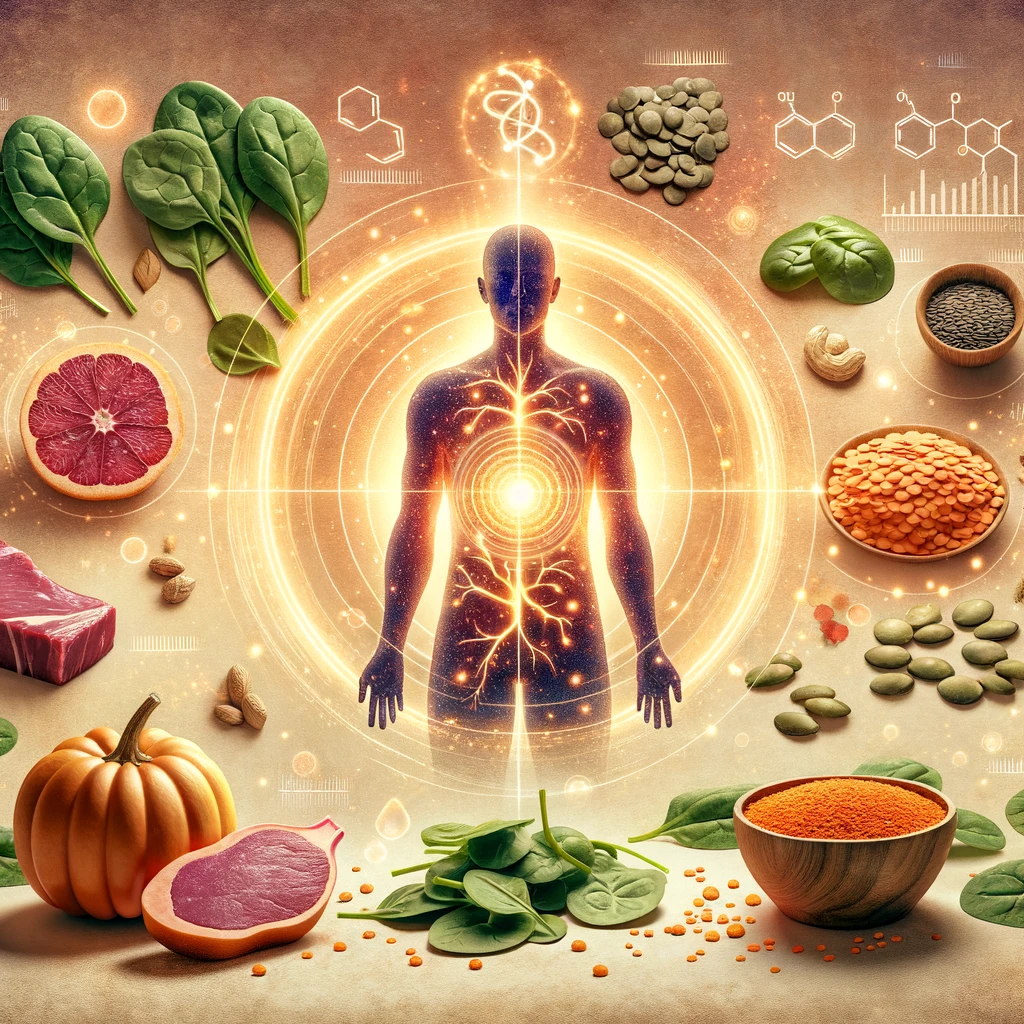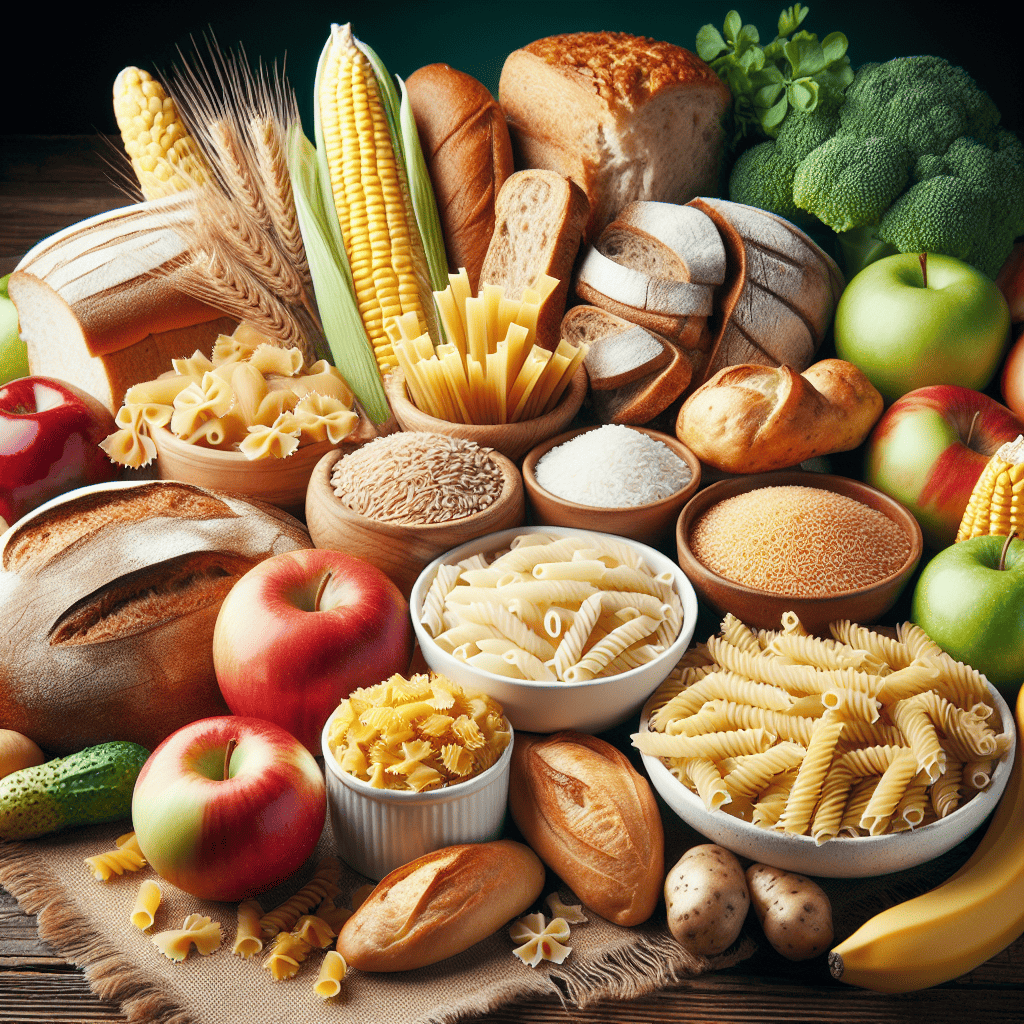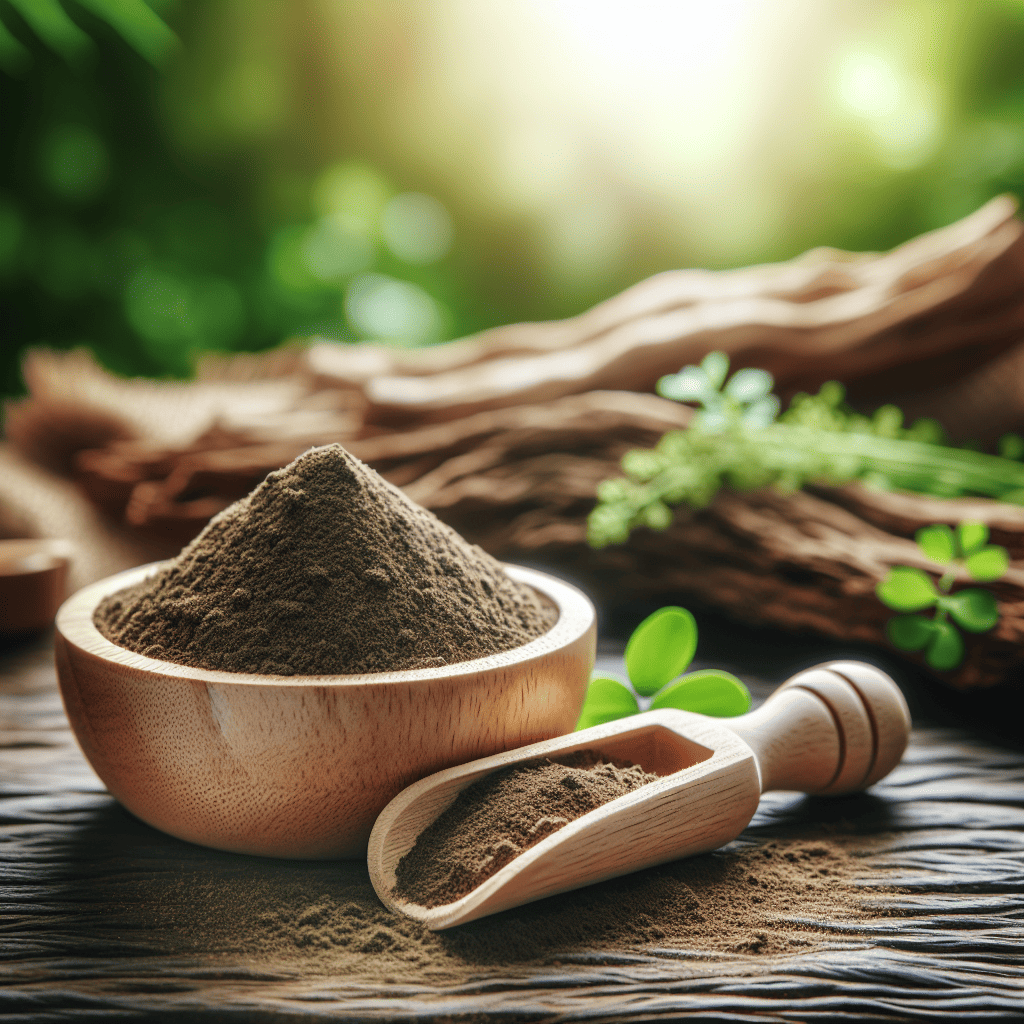Introduction: Iron is a vital mineral necessary for various bodily functions, including oxygen transport, energy production, and immune system support. Iron deficiency is prevalent globally, affecting a significant percentage of the population, highlighting the importance of understanding iron absorption. This blog post delves into the significance of iron, signs of deficiency, factors influencing absorption, sources of iron, and strategies to optimize iron absorption for overall well-being.
Table of Contents
The Role of Iron in the Body
Discover the fundamental functions of iron in the body and why meeting daily iron requirements is crucial.
- Role of Iron in Bodily Functions:
Iron is a crucial mineral that plays a vital role in various essential functions within the body. Hemoglobin, a protein in red blood cells, requires iron to transport oxygen from the lungs to various tissues and organs, ensuring proper cellular function. Similarly, myoglobin, found in muscle cells, stores oxygen and facilitates muscle function, making iron necessary for physical performance and stamina. Iron is also a component of enzymes involved in energy production within cells, aiding in metabolism and overall energy levels. Additionally, iron is essential for DNA synthesis, supporting cell growth, development, and repair processes in the body. These functions highlight the diverse roles iron plays in maintaining overall health and well-being.
A deficiency in iron levels can have significant adverse effects on the body’s functioning. One of the most common symptoms of iron deficiency is fatigue, which occurs due to the reduced capacity of the blood to carry oxygen to tissues and muscles. Cognitive impairment is another consequence of low iron levels, as the brain requires oxygen for optimal functioning. Weakened immunity is also a concern with insufficient iron, as immune cells need proper oxygenation to function effectively in fighting off infections and diseases. Furthermore, iron deficiency can lead to anemia, a condition characterized by low red blood cell count or hemoglobin levels that can cause symptoms like weakness, pale skin, and shortness of breath. This emphasizes the importance of maintaining adequate iron levels through a balanced diet rich in iron-rich foods or supplements when necessary.
Ensuring an adequate intake of iron is crucial for overall health and well-being. While iron is present in various food sources like red meat, poultry, fish, legumes, and leafy greens, certain individuals, such as pregnant women, children, and vegetarians, may have higher iron requirements and need to pay special attention to their intake. Consuming vitamin C-rich foods alongside iron-rich foods can enhance iron absorption, while avoiding consuming calcium-rich foods or beverages like milk simultaneously can help prevent interference with iron absorption. Regular monitoring of iron levels through blood tests and consultation with a healthcare provider can ensure that individuals maintain proper iron levels to support their body’s essential functions and prevent potential health issues associated with iron deficiency.
paragraph 4
- Daily Iron Requirements:
Iron is a vital mineral that plays a crucial role in various bodily functions, including oxygen transport and energy production. The recommended daily intake of iron can vary based on factors such as age, gender, and individual needs. For example, adult males generally need around 8 milligrams of iron per day, while adult females aged 19-50 need about 18 milligrams per day due to the loss of iron during menstruation. Pregnant women have higher iron requirements, with a recommended daily intake of 27 milligrams to support the growing fetus and increased blood volume.
Iron deficiency can lead to a condition called anemia, characterized by fatigue, weakness, and impaired cognitive function. To prevent iron deficiency, it is important to consume a balanced diet that includes iron-rich foods such as lean meats, poultry, seafood, beans, nuts, and fortified cereals. In some cases, supplementation may be necessary, especially for individuals at risk of deficiency, such as vegetarians or individuals with certain medical conditions that affect iron absorption.
It’s important to note that excessive iron intake can also have adverse health effects, so it’s crucial to consult with a healthcare provider before starting iron supplements. They can provide personalized recommendations based on individual needs and help monitor iron levels through blood tests. By understanding the recommended daily intake of iron and incorporating iron-rich foods into your diet, you can support overall health and reduce the risk of deficiency-related complications.
Signs and Symptoms of Iron Deficiency
Learn about the common indicators of iron deficiency and why prompt diagnosis and treatment are essential.
- Physical and Psychological Symptoms:
Iron deficiency is a common condition that can have various symptoms, making it important to recognize the signs early for prompt intervention. One of the primary indicators of iron deficiency is fatigue, as iron is essential for the formation of hemoglobin, which carries oxygen in the blood to tissues and organs. A lack of iron can lead to a decreased oxygen supply to cells, resulting in tiredness and weakness. Additionally, individuals with iron deficiency may experience pale skin, as the reduced hemoglobin levels can affect skin color, making it appear lighter than usual.
Another sign of iron deficiency is shortness of breath, which can occur due to the body’s compromised ability to transport oxygen effectively. When there is insufficient iron to support oxygen delivery, individuals may feel breathless even with minimal physical exertion. Cognitive issues, such as difficulty concentrating or remembering things, can also arise from iron deficiency. Since the brain requires adequate oxygen supply to function optimally, a lack of iron can impact cognitive abilities and lead to cognitive impairment.
Furthermore, brittle nails and hair loss are common symptoms that can indicate iron deficiency. The health of nails and hair is closely related to overall nutrient levels in the body, including iron. Insufficient iron supply can affect the growth and strength of nails, causing them to become weak and brittle. Similarly, hair follicles may be deprived of oxygen and vital nutrients in iron deficiency, leading to hair thinning and loss. If experiencing any of these signs or symptoms of iron deficiency, it is crucial to seek medical advice from a healthcare professional for proper evaluation and treatment. Iron deficiency can have significant health consequences if left untreated, but timely detection and management can help restore iron levels and improve overall well-being.
- Addressing Iron Deficiency:
Iron deficiency is a common problem worldwide, especially among women of childbearing age and young children. Its symptoms can range from fatigue and weakness to more severe issues like impaired cognitive function and compromised immune system. Recognizing these signs early on is crucial to prevent the condition from progressing and causing more serious health problems.
One of the primary ways to address iron deficiency is through dietary changes. Consuming iron-rich foods such as lean meats, poultry, seafood, beans, nuts, and fortified grains can help increase iron levels in the body. Pairing these foods with sources of Vitamin C, which enhances iron absorption, can further optimize the body’s ability to absorb and utilize the iron. For individuals who may struggle to meet their iron needs through diet alone, iron supplements can be recommended by healthcare providers to bridge the gap and ensure adequate iron intake.
In cases where iron deficiency is severe or does not improve with dietary changes and supplements, medical intervention may be necessary. This can involve iron infusion therapy, where iron is delivered directly into the bloodstream, or other interventions based on the underlying cause of the deficiency. Regular monitoring of iron levels and response to treatment is essential to gauge the effectiveness of the chosen intervention and make any necessary adjustments to the treatment plan. Overall, addressing iron deficiency promptly and comprehensively can lead to improved health outcomes and a better quality of life for individuals affected by this condition.
Understanding Iron Absorption
Explore the intricate process of iron absorption in the body and factors influencing its efficacy.
- Heme vs. Non-Heme Iron:
Heme iron is found in animal-derived foods such as meat, poultry, and fish. It is more readily absorbed by the body compared to non-heme iron, which is found in plant-based sources like beans, lentils, spinach, and fortified cereals. The main difference between heme and non-heme iron lies in their chemical structure. Heme iron is bound to hemoglobin and myoglobin in animal tissues, giving it a unique structure that is easily recognized and absorbed by the body. On the other hand, non-heme iron is not bound to these proteins and exists in a different chemical form, making it less efficiently absorbed by the gut.
When it comes to absorption, heme iron is absorbed more efficiently by the body compared to non-heme iron. The absorption of heme iron is not significantly influenced by other dietary components and is absorbed directly into the bloodstream by specialized transporters in the gut. In contrast, non-heme iron absorption can be affected by various factors. For example, certain substances like phytates found in whole grains and legumes, and polyphenols in tea and coffee can inhibit the absorption of non-heme iron. However, there are ways to enhance the absorption of non-heme iron. Consuming vitamin C-rich foods like citrus fruits, strawberries, or bell peppers alongside non-heme iron sources can significantly boost its absorption. Vitamin C helps convert non-heme iron into a more soluble form, making it easier for the body to absorb.
To enhance iron uptake, individuals, especially vegetarians or those with low iron levels, can incorporate both heme and non-heme iron sources into their diet. Including lean meats, poultry, or seafood alongside plant-based iron sources can provide a mix of both types of iron, maximizing overall absorption. Additionally, pairing plant-based iron-rich foods with vitamin C sources can further improve non-heme iron absorption. Cooking techniques can also influence the availability of iron in foods. For instance, soaking, sprouting, or fermenting grains and legumes can help reduce the phytate content, enhancing the absorption of non-heme iron. By understanding the differences between heme and non-heme iron absorption and implementing strategies to optimize iron uptake, individuals can ensure they meet their daily iron requirements for optimal health.
- Regulation of Iron Absorption:
Iron absorption is a tightly regulated process in the human body aimed at maintaining a delicate balance since excess iron can lead to toxicity while inadequate levels can result in anemia. The body’s regulation of iron absorption is mainly controlled by hepcidin, a hormone produced by the liver in response to systemic iron levels. When the body has sufficient iron stores, hepcidin levels increase, which in turn reduces the absorption of iron from the diet. On the other hand, when iron stores are low, hepcidin levels decrease, allowing for increased absorption of dietary iron to replenish stores. This intricate feedback mechanism ensures that the body adapts its absorption of iron based on its current needs.
Several factors can influence the absorption of iron from the diet. One key factor is the form of iron consumed. Iron comes in two forms: heme iron, found in animal products, and non-heme iron, present in plant-based foods. Heme iron is more readily absorbed by the body compared to non-heme iron. Consuming vitamin C-rich foods alongside non-heme iron sources can enhance its absorption, as vitamin C helps convert non-heme iron into a more bioavailable form. On the other hand, substances like tannins in tea and phytates in whole grains can inhibit iron absorption. Therefore, dietary choices and combinations play a crucial role in optimizing iron absorption.
Individual variations also play a role in how efficiently the body absorbs iron. Factors such as age, sex, and overall health can influence iron absorption rates. For instance, women of reproductive age have higher iron requirements due to menstrual blood loss, making them more susceptible to iron deficiency. Additionally, certain medical conditions like celiac disease or gastric bypass surgery can affect iron absorption. Understanding these individual variations and incorporating strategies like consuming iron-rich foods alongside vitamin C sources, avoiding inhibitors like tea or coffee with iron-rich meals, and ensuring adequate overall nutrient intake can help optimize iron absorption and prevent deficiencies.
Factors that Affect Iron Absorption
Identify the various factors that can hinder or enhance the absorption of iron in the body.
- Inhibitors of Iron Absorption:
Iron absorption can be influenced by various substances in the diet such as phytates, oxalates, and tannins. Phytates are compounds found in whole grains, legumes, nuts, and seeds. These compounds can bind to iron and inhibit its absorption in the gut. Similarly, oxalates are found in foods like spinach, rhubarb, and almonds, and they can also interfere with the absorption of iron. Tannins are another group of compounds present in tea, coffee, and certain fruits like grapes and berries, which can reduce iron absorption. By understanding these inhibitors, individuals can make informed dietary choices to ensure optimal iron intake.
On the other hand, consuming calcium-rich foods alongside iron-rich foods can also impede iron absorption. Calcium competes with iron for absorption in the gut, so consuming large amounts of dairy products, fortified plant-based milks, or calcium supplements with iron-rich meals can decrease the amount of iron absorbed by the body. To mitigate this effect, it is advisable to space out consumption of calcium-rich foods and iron-rich foods throughout the day. For individuals looking to improve their iron status, incorporating foods high in vitamin C during meals can help enhance iron absorption. Vitamin C-rich foods like citrus fruits, bell peppers, and strawberries can help convert non-heme iron (from plant-based sources) into a more absorbable form.
Incorporating strategies to counteract the impact of phytates, oxalates, tannins, and calcium on iron absorption can contribute to better overall iron status. These strategies include soaking, sprouting, or fermenting grains, legumes, nuts, and seeds to reduce phytate levels. Cooking foods high in oxalates such as spinach can also help decrease their inhibitory effects on iron absorption. Furthermore, choosing herbal teas over tannin-rich black tea and coffee can be a beneficial swap. By balancing the intake of iron-rich foods with those that enhance absorption, individuals can optimize their iron levels and promote better overall health.
- Enhancers of Iron Absorption:
Iron is an essential mineral crucial for various bodily functions such as transporting oxygen in the blood. However, iron absorption can be influenced by dietary factors, particularly vitamin C. Consuming vitamin C-rich foods alongside iron-rich sources can significantly enhance the body’s ability to absorb iron. Vitamin C aids in converting the non-heme iron found in plant-based foods and supplements into a more readily absorbable form, known as ferrous iron. By creating a more soluble form of iron through this interaction, vitamin C effectively improves the overall absorption of iron in the body. Therefore, incorporating vitamin C-rich foods like citrus fruits, strawberries, bell peppers, and broccoli into meals that contain iron sources like lean meats, seafood, legumes, and leafy greens can optimize iron absorption and prevent deficiencies.
Moreover, understanding the importance of enhancing iron absorption is crucial for overall health and well-being. Iron deficiency is one of the most common nutritional deficiencies worldwide and can lead to symptoms such as fatigue, weakness, pale skin, and impaired cognitive function. By strategically pairing vitamin C-rich foods with iron sources, individuals can increase their body’s uptake of this vital mineral, thus reducing the risk of developing iron deficiency anemia. Additionally, promoting efficient iron absorption through dietary modifications can be particularly beneficial for certain populations at a higher risk of iron deficiency, such as pregnant women, growing children, and vegetarians or vegans who rely on plant-based sources of iron. By adopting a well-balanced diet that synergistically combines vitamin C and iron-rich foods, individuals can optimize their nutrient intake and support better health outcomes.
In conclusion, the synergistic relationship between vitamin C and iron absorption illustrates the significance of tailoring one’s diet to maximize the nutritional benefits of these essential nutrients. By recognizing how certain dietary components can influence the bioavailability of iron, individuals can make informed choices to support optimal iron levels in the body. Through strategic meal planning that incorporates a variety of vitamin C-rich foods and iron sources, such as combining a spinach salad with strawberries and grilled chicken or pairing lentil soup with a side of bell peppers, individuals can enhance their overall nutrient absorption and promote better health. Ultimately, by leveraging the powerful partnership between vitamin C and iron, one can proactively prevent deficiencies, maintain proper iron levels, and support overall well-being through a nutrient-rich diet.
Foods High in Iron
Discover a variety of iron-rich foods that can support meeting daily iron requirements and preventing deficiency.
- Sources of Heme and Non-Heme Iron:
Iron is an essential mineral that plays a crucial role in maintaining overall health. One of the primary sources of iron is red meat, such as beef, lamb, and pork. These meats contain heme iron, which is highly absorbable by the body. Consuming lean cuts of red meat can significantly contribute to meeting your daily iron requirements. Additionally, liver is another excellent source of iron, offering a high concentration of heme iron. Including liver in your diet occasionally can boost your iron intake.
Poultry, including chicken and turkey, is another valuable source of iron. While poultry contains non-heme iron, which is not as easily absorbed as heme iron, pairing it with foods rich in vitamin C can enhance iron absorption. Legumes, such as beans, lentils, and chickpeas, are plant-based sources of iron. Legumes also provide fiber and protein, making them a nutritious choice for boosting iron levels in vegetarian or vegan diets. Tofu, made from soybeans, is another plant-based iron source that is versatile and can be incorporated into various dishes.
Green leafy vegetables like spinach are known for their iron content. Spinach contains non-heme iron and is best consumed alongside vitamin C-rich foods to improve absorption. Fortified cereals are commonly enriched with iron and other essential nutrients, making them a convenient option for increasing iron intake. Nuts, such as almonds, cashews, and pistachios, are also good sources of iron. Including a variety of iron-rich foods in your diet can help prevent iron deficiency and maintain optimal iron levels for overall well-being.
- Optimizing Iron Bioavailability:
Iron is an essential mineral that plays a crucial role in various bodily functions, including the transportation of oxygen and the production of energy. It is particularly important for individuals with increased iron needs such as pregnant women, growing children, and individuals with certain medical conditions. Iron is available in two main forms in the diet: heme iron and non-heme iron. Heme iron, found in animal products such as meat, poultry, and fish, is more easily absorbed by the body compared to non-heme iron, which is found in plant-based sources like beans, lentils, and leafy greens. Despite the difference in absorption rates, non-heme iron can still be a valuable source of iron in the diet, especially for vegetarians and vegans.
Combining heme and non-heme iron sources in a meal can help enhance the overall absorption of iron. Consuming foods rich in vitamin C, such as citrus fruits, bell peppers, and tomatoes, alongside non-heme iron sources can significantly increase the absorption of iron. Vitamin C helps convert non-heme iron into a more absorbable form, facilitating its uptake by the body. Additionally, avoiding consuming calcium-rich foods or beverages like dairy products or coffee with iron-rich meals can also improve iron absorption. Calcium can inhibit the absorption of both heme and non-heme iron, so it is advisable to consume these foods separately for optimal iron absorption.
By understanding the bioavailability of iron from different sources and how to strategically combine heme and non-heme iron with other nutrients, individuals can maximize the nutritional benefits of their diet. Including a variety of iron-rich foods in meals, such as lean meats, poultry, seafood, legumes, nuts, seeds, and dark leafy greens, can help ensure an adequate intake of this vital mineral. It’s also important to keep in mind that iron absorption can be influenced by various factors like individual iron status, overall diet composition, and the presence of other nutrients. Consulting with a healthcare provider or a registered dietitian can help individuals create a well-rounded diet plan that optimizes iron absorption and promotes overall health and well-being.
Enhancing Iron Absorption
Learn effective strategies to boost iron absorption and optimize the utilization of dietary iron.
- Utilizing Vitamin C for Enhanced Absorption:
Iron is an essential mineral that plays a crucial role in various bodily functions, such as oxygen transport, energy production, and DNA synthesis. However, the body does not efficiently absorb iron from plant-based sources, known as non-heme iron, compared to animal-based sources like heme iron. By incorporating vitamin C-rich foods or beverages, such as citrus fruits, strawberries, bell peppers, or orange juice, alongside iron-rich meals, the absorption of non-heme iron can be significantly enhanced. Vitamin C helps to convert non-heme iron into a more easily absorbable form, increasing the overall bioavailability of iron in the body. This synergistic combination can be particularly beneficial for individuals who follow vegetarian or vegan diets, as they primarily rely on non-heme iron sources for meeting their iron needs.
Moreover, the synergistic effect of vitamin C and iron can be especially important for individuals at risk of iron deficiency or those with conditions that impede iron absorption, such as anemia. Iron deficiency is a common nutritional disorder worldwide and can lead to symptoms like fatigue, weakness, and impaired cognitive function if left untreated. By strategically pairing vitamin C-rich foods with iron-rich meals, individuals can optimize their iron absorption and potentially prevent or alleviate iron deficiency. This nutritional strategy is not only effective but also simple to incorporate into daily meals by including fruits, vegetables, or juices high in vitamin C alongside iron-fortified cereals, legumes, nuts, or seeds.
In conclusion, the combination of vitamin C-rich foods or beverages with iron-rich meals represents a practical and natural approach to improve iron absorption in the body. Whether aiming to boost iron levels for better overall health or addressing specific nutrient deficiencies, this synergistic strategy offers a convenient and cost-effective way to enhance the bioavailability of iron without the need for supplementation. By promoting a balanced diet that includes a variety of nutrient-dense foods, individuals can support their iron status and overall well-being through simple dietary modifications that maximize nutrient uptake and utilization.
- Avoiding Iron Absorption Inhibitors:
Iron absorption can be hindered by various substances like tea, coffee, and calcium. Tea and coffee contain compounds called tannins that can bind to iron and inhibit its absorption by the body. Calcium, commonly found in dairy products, can also interfere with the absorption of iron when consumed together. These substances should be avoided or consumed separately from iron-rich foods to maximize the body’s ability to absorb and utilize iron effectively.
To strategize meal planning for optimal iron absorption, one approach is to consume iron-rich foods with sources of vitamin C. Vitamin C helps enhance the absorption of non-heme iron, the type of iron found in plant-based sources. Including fruits high in vitamin C such as oranges, strawberries, or bell peppers in meals containing iron-rich foods like beans, lentils, or spinach can improve iron uptake. Additionally, pairing iron-rich foods with foods low in tannins or calcium can also aid in maximizing iron absorption. For example, instead of having a cup of coffee with a meal, opt for a glass of orange juice to boost the absorption of iron from plant-based sources.
Simple dietary adjustments can significantly improve the efficiency of iron uptake in the body. Apart from being mindful of substances that hinder iron absorption, it is important to balance the inclusion of iron-rich foods with enhancers like vitamin C while minimizing inhibitors like tea, coffee, and high-calcium foods. Planning well-rounded meals that incorporate a variety of nutrient-dense foods can help ensure adequate iron intake and absorption. Regularly including sources of heme iron, found in animal products like lean meats and seafood, along with non-heme iron from plant-based sources can further support iron levels in the body. By adopting these dietary strategies, individuals can optimize iron absorption and support overall health and well-being.




